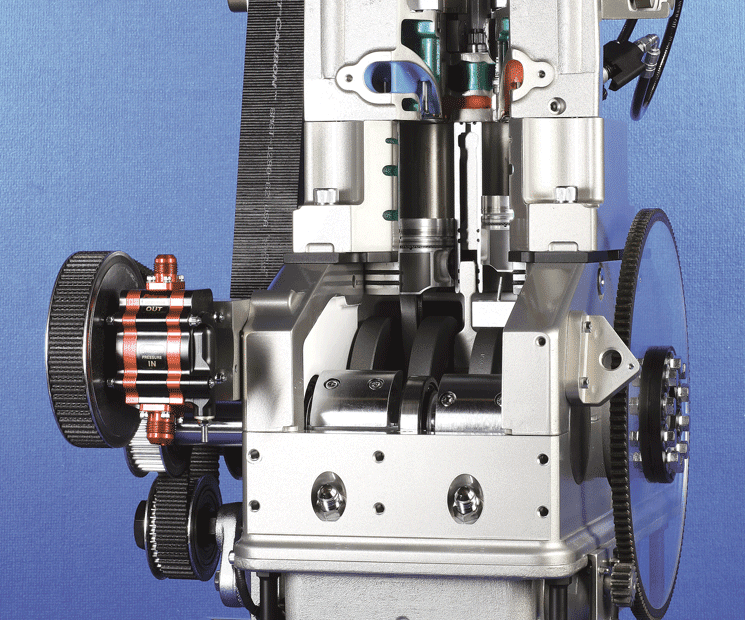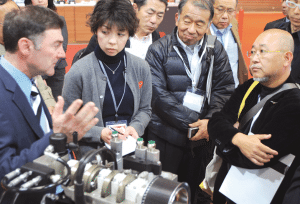
Engine of Progress
Scuderi Group Continues to Seek Its Next Breakthrough
Changing the world isn’t easy. But the Scuderi family never expected that it would be.“Our biggest hurdle, basically, was getting the engine to work. That took a lot of engineering,” said Bill Wrenn, director of marketing for the Scuderi Group, the West Springfield-based company that has spent the past decade attempting no less than a revolution in energy-efficient automotive technology.
“We first fired it up on June 25, 2009; that’s when we got the prototype up and running for the first time,” Wrenn continued. “And that really was the biggest question leading up to that point: will this work? Well, it not only works, but it has worked a lot better than anyone had thought originally.”
The promise of the Scuderi split-cycle engine, as it’s called, is that it could dramatically increase the efficiency of a machine — the internal-combustion engine — that has been notoriously resistant to such efforts in the more than 130 years since it was invented.
It all began in the mind of Carmelo Scuderi, who developed the concept shortly before he died in 2002. His sons — Sal, Stephen, and Angelo — have spent the years since honing the idea, raising millions of dollars in research funding, and preparing to market the final product. They were aided in building a prototype by Southwest Research Institute in San Antonio, Texas., and have since opened offices in the automotive hotbeds of Germany and Japan, making the Scuderi brand an international presence.
But the amount of hype surrounding the engine has some wondering when it might finally appear in a marketable vehicle. To which Wrinn urges patience, while fully acknowledging the complicated nature of the Scuderis’ efforts.
“Anyone who’s not skeptical about this engine doesn’t understand the complexity of the combustion engine,” he told BusinessWest. “It’s not like trying to build new office furniture and sell it; these are very scientific processes we’re working on.”
But he pooh-poohs any notion that the auto or energy industry has hindered progress on a more energy-efficient machine. “We’ve had no visits from men in dark blue suits telling us to go away,” he said with a laugh. “But the attraction has varied from continent to continent and continues to change.”
Change Resistant
The first four-stroke piston engine was developed in 1876, and remains the primary design of engines today. And despite the myriad changes to automotive technology over the past century-plus, the efficiency of this engine design has remained largely unchanged. Specifically, it operates at about 33% efficiency, meaning that only one-third of the energy in each gallon of fuel is used to power the machine, and the rest is lost through friction and heat.
The Scuderi Group believes their model could finally change that equation. They note that the heart of the internal-combustion engine is a piston connected to a crankshaft, moving up and down in a cylinder through the intake, compression, power, and exhaust strokes. In a typical four-stroke cycle engine, power is recovered from the combustion process in these four separate piston strokes within each single cylinder.
The Scuderi split-cycle engine changes the heart of the conventional engine by dividing the four strokes of this cycle over a paired combination of one compression cylinder and one power cylinder. Gas is compressed in the compression cylinder and transferred to the power cylinder through a gas passage.
The gas passage includes a set of uniquely timed valves, which maintain a precharged pressure through all four strokes of the cycle. Shortly after the piston in the power cylinder reaches its top, center position, the gas is quickly transferred to the power cylinder and fired (or combusted) to produce the power stroke.
By splitting the strokes of the cycle over a pair of dedicated compression and power cylinders, the design of each cylinder can be independently optimized to perform the separate tasks of compression and power.
The Scuderis have called the engine “disruptive technology,” meaning it has the potential to shake up an industry. Wrenn said the family has been pleased with the engine’s performance so far.“To put it in perspective, we’re at the genesis of a new thermodynamic process, a new way of creating combustion that has never been discovered before,” he said. “We’re discovering interesting new facts about the engine’s potential ability to do certain things and how much power it can produce.”
Since the prototype was completed, Wrenn said, “we’ve spent a lot of time collecting statistics and measurements and simulating how the engine would work in typical vehicles. One test took a typical European economy-class vehicle — these are some of the most efficient vehicles in the world — and, with the Scuderi engine, took the car through a typical drive cycle in various driving modes. What we found was, where normally those cars would get 52 miles to the gallon, the Scuderi engine got more than 65. On the emissions side, we emitted 85 grams of CO2 per kilometer, compared to a conventional engine with 104 grams per kilometer.”
Beyond the basic concept, the company is generating additional energy savings from an innovation it calls the air hybrid, in which it stores energy as compressed air during braking and feeds it into the combustion cylinder when the car is accelerating. Electric hybrids also use braking force to store energy, but in a battery, and the Scuderi Group points out that batteries are costly, heavy, and wear out — and are hazardous to dispose of.
Sal Scuderi told the Wall Street Journal recently that the company is getting close to licensing its technology for production, but scoring an automotive customer is challenging. “You can’t beat [incumbent engine designs] by a little bit. You have to beat them by a lot.”
The test Wrenn cited may fall under the ‘little bit’ category, but, “since then, the data has gotten even better,” he told BusinessWest. “Since then, we’ve made tweaks on our valve systems, and we’ve found that we can manipulate it even more, increasing power and also bringing down fuel combustion. That has been an extremely exciting discovery.”
The Next Phase
Wrenn said the Scuderi family is fond of the quote often attributed to Mahatma Gandhi: “first they ignore you, then they ridicule you, then they fight you, then you win.”
“We’re definitely going through those stages right now, and we’re turning a corner where it’s becoming more accepted,” he said. “It’s been really interesting.”
For example, “our engine has applications in other industries,” he noted. “I think everyone has associated us with the automotive industry. Yes, it’s a car engine, but we are now being looked at as a solution not just for automotive applications, but power generators, compressed-air energy-storage solutions, and distributed power.”
He said the Scuderi Group has negotiated with multiple manufacturers in more than one industry and could be close to a licensing deal, although he could share no details yet. But he said the confidence of the family in their father’s dream has never wavered.
“As new discoveries have created new opportunities for success, we’re even more excited about it,” Wrenn said, adding that one of the most intriguing parts of the process has been opening up the concept to engineers of all stripes.
“The family chose long ago to begin to promote the technology, but at the same time it’s being developed, we wanted to bring the engineering community along for the ride,” he explained. “We’ve always known that, once the engine starts to get worked on by the greater engineering community around the globe, they’re going to discover a few new things and make it better. We think that’s fascinating and a great thing.”
In other words, the biggest news with the Scuderi split-cycle engine is still a ways down the highway — and this globetrotting family is enjoying the ride.
Joseph Bednar can be reached at [email protected]








